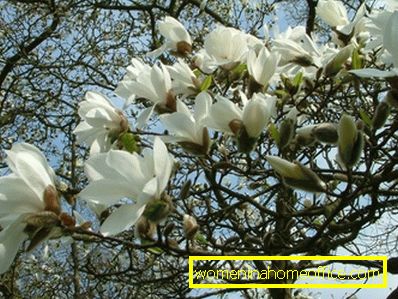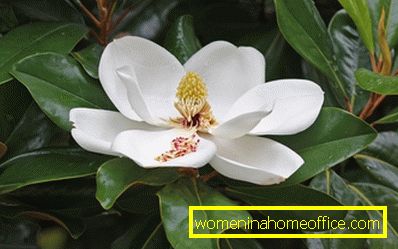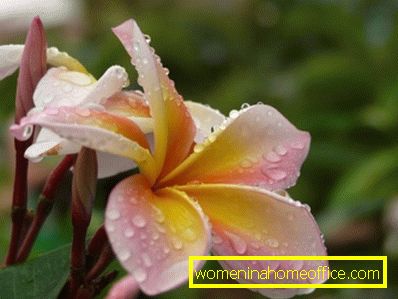Magnolia
Magnolia is an unusual rare plant. The leaves are simple, and the flowers are large, with white, cream, yellow, pink, purple or purple color. Their buds exude a pleasant and very delicate scent. Magnolia has decorative fruits that become a real decoration of the tree from the end of summer until the end of the autumn period. Excellent magnolia will look if it is planted on a site separately from shrubs and trees, as well as on the background of evergreen conifers.
Immediately before planting the seedlings into the ground, it is necessary to study the microclimate of the site well and choose a sunny, fenced from the east and north winds place. On the southern side of the magnolia is best to knead in partial shade.
Certain types of plants, such as cobus, lebner, stellate, and some others are able to grow in open areas. But decorative, like sulange, ziebold, Chinese - should be planted in places that are protected from direct sunlight.
Magnolia is not too picky about the soil, but it will grow better in slightly acid-rich organic soil. For planting seedlings you can prepare a mixture of the following components in proportion: turf ground - 2 parts, peat - 1 part, compost - 1 part.

The soil for planting should be loose, moderately moist and well drained. In case it is too dense, it should be mixed with sand or any other baking powder. In addition, it is recommended to bring rotten horse manure to the soil. The size of the pit for planting should be three times the volume of the root system of the seedling itself. Immediately after the landing, the ground around it should not be strongly compacted, otherwise you can damage the fragile roots. But the tree trunk must be covered with bark of coniferous trees so that the moisture level in the soil remains normal.
It is important to ensure that the roots of the plant are not dry before planting, for this purpose it is best to purchase a seedling in a container. Thus, the magnolia will more easily plant in open soil, since it will be made with the clod of earth in which the plant was already located.
Magnolia, which was purchased in a container, can be planted in open ground throughout the warm period, but it is better to do it in the fall. It is at this time of year that she is at rest. A sapling is better to choose the one on which there are flower buds - these are easy to distinguish in appearance from others.
If the planting was carried out in the spring, the plant begins to actively stretch, the sapling gives a good growth and often starts wintering with shoots that have not yet had time to woody. In this case, they shoots just die off in the winter.
In the first 2-3 years after planting in open ground, the lower part of the stem of the plant and the root system need to be covered for the winter with special winter agrofabric, coniferous branches or straw.
In the penumbra, young seedlings should be planted immediately to a permanent place of cultivation, this plant has a negative attitude to transplants. Between each specimens need to leave a distance of 4-5 m, and if the area is not large, then the magnolia should be planted in groups of 3-4 plants. For example, let 1 plant be a tree, and already about him 3 or 4 bush.
How to grow magnolia in the middle lane?

- If the planting was carried out correctly, it will actively grow and develop, and its flowering even in the climate of the middle zone will begin earlier and will be characterized by abundance and pomp. If summer will be dry, the tree should be watered abundantly with not too cold water, but you should not re-moisten the soil!
- Within a radius of 50 cm from the plant, the ground surface is usually mulched so that the evaporation of moisture decreases. Neither before planting the seedlings, nor after it, it will be impossible to allow overdrying of the ground. Next to the trunk, the ground is also not recommended to be treated with a garden rake or shovel, since this plant has a surface root system.
- During the development of leaves and fruits, magnolia should be fed with a full range of mineral fertilizers - this will help develop better and reduce the detrimental effect of weather factors. The last dressing should be done no later than July, because at the end of August the magnolia goes into a state of rest and begins to gradually prepare for wintering.
- After the leaves fall from the plant, it most often occurs in late October - November, the soil under it should be covered with fallen leaves, pine bark or pine needles, a layer of 20-30 cm thick, so that the roots do not freeze.
- Magnolia does not need special pruning, and dry branches and floral ovaries that have frozen through the winter need to be trimmed only after flowering. You should also cut the branches that grow inside the crown. This procedure helps to improve the decorative appearance of the magnolia, as well as its growth and development. By the way, fresh slices must be processed with a garden bar.
- If the leaves of the plant begin to turn yellow due to insufficient iron content in the soil (by the way, this is the first sign of chlorosis), the soil should be watered, and the leaves themselves should be sprayed with a solution of iron chelate. But despite this, the magnolia is practically not sick and does not attract the attention of garden pests.
Ziebold Magnolia: Features of Planting and Care


China, Japan and the Korean Peninsula are considered the birthplace of this magnolia, it has been cultivated since 1865. It is a small tree, deciduous, but high shrubs are also often found. Siebold leaves are wide, up to 15 cm in length, the flowers are bowl-shaped, 7-10 cm in diameter. These are white buds, emitting a pleasant aroma, slightly drooping, the pedicle is thin and lowered. The plant begins to bloom in the month of June, after the leafing.
Among all magnolias, Siebold is the most frost-resistant. Mature plants, without any damage, can transfer the temperature of the Dominus 36 degrees, and based on the statements of some sources, even up to minus 39 degrees!
A beautiful visual representative of this plant is located in Russia in the city of Vladivostok, where about 30 years ago Siebold was brought from the DPRK. The northern limit of cultivation of this magnolia is 100 km to the south. Seedlings, which were grown from seeds collected from plants growing near the northern border of the habitat area, have proven to be very resistant. In Primorye in 2000–2001, very cold winters stood out, the air temperature was extremely low, and this lasted for quite a long time. But, despite these severe weather conditions, the magnolia of the zabold steadfastly endured all the weather conditions without any observable damage, and at the end of winter it bloomed magnificently and abundantly bore fruit.
Also, the fruiting and flowering representatives of this plant species are located in Kiev and St. Petersburg. Despite only relatively cold winters, seedlings aged 1-2 g, which were left uncovered in the garden, may have some damage at the tips of the shoots at the end of the winter period. But plants of age 3 g and reaching a height of about 1 m, absolutely do not suffer even from air temperature of minus 33 degrees.
It is good to grow Siebold magnolia almost all over the European territory of Russia, and in large tubs it can be cultivated even in Siberia and the Urals.
Planting and caring for this type of magnolia does not differ from other species. It is also necessary to plant it in the penumbra and do not forget about feeding and watering.
Magnolia: photo




See also:Bonsai at home
Magnolia is a beautiful perennial plant, blooming with magnificent fragrant flowers. It will create an atmosphere of southern nature in your backyard. Despite some exoticism for the middle band, magnolia is quite hardy and unpretentious in its care.